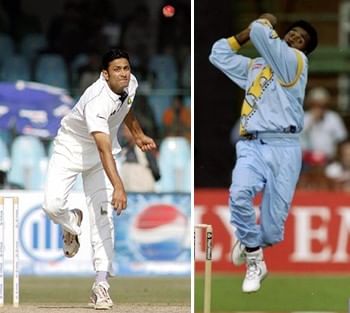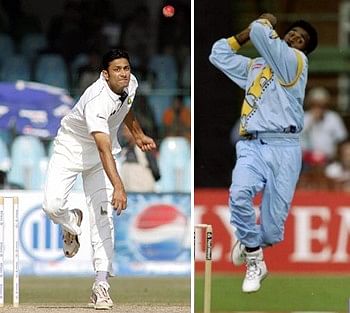
When Anil Kumble and Javagal Srinath bowled to a non-existent batsman

When Steven Finn returned to the English side in the third Test and picked up two for 38 in the first innings, Ricky Ponting said, “He looked in good rhythm today”. The words proved to be prophetic as Finn returned in the second innings to pick up a match-winning 6 for 79. Unfortunately for Michael Clarke’s men, every single English bowler has looked in great rhythm as they’ve practically taken turns to decimate their arch rivals.
There is plenty of talk already about how England managed to seal the series with a Test still to play. Much has been said of their recent stint in Spain as having contributed to their superlative catching. And as the series draws to a close, much more will be written about the superlative English bowling.
As a fan of the sport, I couldn’t help but spare a thought about all the behind-the-scenes work that might have contributed to the splendid Ashes victory. It was then that my mind raced back to something that I had witnessed first-hand several years ago, in what was to become an education of sorts in bowling preparation.
The training grounds
In the year 2000, the National Cricket Academy (NCA) was set up at the Chinnaswamy Stadium in Bangalore with an oval field serving as its training ground. Much before the NCA came into existence, this oval field was quite simply referred to as the Karnataka State Cricket Association – B (KSCA-B) ground.
Famous for the annual summer camps, the KSCA-B was the training ground for several cricket clubs in Bangalore. A forever match-ready central pitch was bordered by a string of practice pitches at long-off, long-on, fine-leg and third-man on either side.
The clubs that played in the KSCA league pitched their nets here and practised in the evenings. It was in these nets that club cricketers toiled away while harbouring dreams of graduating to the imposing stadium that stood next door.
Despite being housed in the stadium premises, the sight of a recognizable Indian star was a rarity. It was inside the stadium that the state Ranji Trophy team trained. The Indian team – although occasionally – also trained inside at camps held before an overseas tour.
For the lesser mortals i.e. club cricketers, the KSCA-B turf was home. Which is precisely why we were in for a pleasant surprise one evening when Anil Kumble and Javagal Srinath turned up on the “B” grounds.
Enter Kumble and Srinath
In the mid-90s, Srinath spearheaded the Indian fast bowling attack while Kumble was gaining repute as a destructive leg-spinner. As they walked onto the grounds in cricketing flannel, it was evident that they weren’t there for an evening stroll on the lawns.
Having examined the central pitch, they went straight towards our nets. I had to pinch myself – Kumble and Srinath were an arm’s length away. They spoke to our club coach about lending a “good” wicket-keeper for the evening. They were going to use the centre pitch for some bowling drills.
“Nets” and practice sessions for me back then were all about fast bowlers running in with all their might and spinners using all their guile to knock over batsmen. So I was baffled when Kumble and Srinath did some stretching and then marked their run-ups to bowl with no batsman facing up to them. There was just our keeper at the far end who was visibly excited and nervous at the prospect of keeping to India’s premier bowlers.
And then the show began.
Kumble walked up gingerly and sent down floaters which the keeper duly gathered, much to our coach’s relief. The towering leg-spinner repeated this a few more times and then it was Srinath’s turn to do the same – a seam up ball delivered after a gentle and short run-up.
They took turns after bowling an over each, and for the first 15 minutes it was all in slow motion. Some of our star club batsmen salivated at the prospect of being called up to face India’s premier bowlers bowling at pedestrian pace. Alas, this wasn’t to happen.
After the first set of 15 minutes, the momentum picked up. Srinath’s run-up was now short yet purposeful, and the delivery action brisk. Kumble now started running in as well. 15 minutes later, action at our club “nets” had stalled.
Instead, all heads were turned in the direction of Kumble and Srinath, who were by now bowling with their full run-ups. Srinath was leaping up to send down his customary in-dippers with the occasional grunt on release, and Kumble had our keeper grass several bouncing top-spinners.
They were now working up a steady sweat and continued to do so for the next 20 minutes. Every time Kumble sent down a delivery, our keeper hopped to gather – an indication of the bounce that was being generated off the turf. And when Srinath bowled, the ball thudded into the 19-year-old keeper’s gloves, sending him a step back in his stance.
The “Mysore Express” was, by now, clearly working up a steady pace.
The realisation
As we watched the duo in action, we chuckled after every ball. None of their deliveries were striking the stumps despite a full run-up being employed. This seemed utterly bizarre to us as these were international bowlers of some repute and we expected the sticks to be flying in all directions with repeated regularity.
There were, however, several aspects that were visibly striking. The run-up was measured; the ball was pitched at virtually the same position every single time, and our wicket-keeper – who must’ve felt like a kid in a candy store – didn’t have to move sideways to gather.
And just as abruptly as this strange routine commenced, it ended. An hour into their strides, Kumble and Srinath simply looked at each other, nodded in affirmation and stopped.
As they walked up to our coach to thank him, we eagerly nudged closer while straining our ear to eavesdrop. Srinath said that they were working to build up a steady rhythm. I overheard Kumble stating that he was working on imparting topspin and trying to get a high wrist position while ensuring a consistent leap before delivery.
It was only then that it dawned on us kids that the objective wasn’t to break the stumps and draw cheers, but to fine tune their bowling.
Way back in 2002, when The Guardian quizzed Brett Lee about how he managed to work up the amount of pace that he did, Lee said – “It's all about rhythm and getting your body to click”. When I now look back on that memorable evening in Bangalore, it all makes sense.
There are coaching manuals and techniques aplenty about the fabled “bowling rhythm” and how to master it. Kumble and Srinath had their own method, and as it turned out on that evening, it did involve bowling – but not to a batsman.